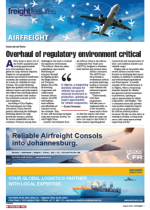The airfreight sector faces unrelenting pressure on margins in a highly competitive market. Debby Gray, Johannesburg airfreight branch manager at SACO CFR, said competition in the sector remained high. However, amidst this challenging landscape, a glimmer of stability has emerged thanks to airfreight rates being more stable than in years. Moreover, the increasing prevalence of contract rates, said Gray, was providing this much-needed stability.The airfreight industry has long been plagued by volatility, with f luctuating rates based on factors such as fuel prices, demand-supply imbalances, and geopolitical events. For a considerable period, businesses across sectors have grappled with uncertain and soaring airfreight costs, making financial planning and supply chain management an arduous task.Nevertheless, recent market trends suggest a positive shift in the airfreight landscape. Gray said airfreight rates had been relatively stable over the past few quarters. This newfound stability is attributed to a combination of factors, including improved operational efficiency, increased competition among carriers, and greater utilisation of cargo space."At SACO CFR, we have implemented new gateways in the USA that we continue to develop. We are working on a second tier to our current service, a very competitively priced direct service from mainland USA to South Africa," she told Freight News. "However, we have identified an apparent demand in the present market for a more affordable service option with extended transit times. We are actively working towards implementing this solution to cater to our customers’ needs.” According to Gray, while they are seeing a significant increase in the number of shipments handled per month, there has been a gradual decline in the average size per shipment. This trend was likely a result of larger volumes being transported via sea freight, driven by the attractive low pricing it offered, she said.

